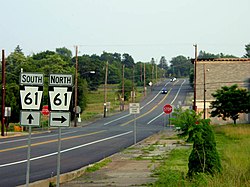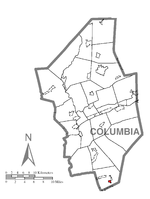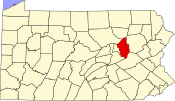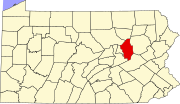Centralia, Pennsylvania
From Wikipedia, the free encyclopedia
| Centralia, Pennsylvania | |
| A view of Centralia | |
| Map showing Centralia in Columbia County | |
| Map showing Columbia County in Pennsylvania | |
| Pennsylvania | |
| Coordinates: | |
| Country | United States |
|---|---|
| State | Pennsylvania |
| County | Columbia |
| Settled | 1841 |
| Incorporated | 1866 |
| Government | |
| - Mayor | Lamar Mervine |
| Area | |
| - Total | 0.2 sq mi (0.6 km2) |
| Population (2000) | |
| - Total | 21 |
| - Density | 87.5/sq mi (33.8/km2) |
| Time zone | Eastern (EST) (UTC-5) |
| - Summer (DST) | EDT (UTC-4) |
| Zip code | 17921 |
| Area code(s) | 570 |
| Website | http://centraliapa.com/ |
Centralia is a borough in Columbia County, Pennsylvania, United States. Its population has dwindled from over 1,000 residents in 1981 to 12 in 2005[1] and 9 in 2007,[2] as a result of a mine fire burning beneath the borough since 1962. Centralia is now the least-populous municipality in Pennsylvania, with four fewer residents than the borough of S.N.P.J.
Centralia is part of the Bloomsburg–Berwick Micropolitan Statistical Area.
Contents |
[edit] History
[edit] Early history
Johnathan Faust opened Bull's Head Tavern in 1841 in what was then Roaring Creek Township. In 1854, Alexander W. Rea, a civil and mining engineer for the Locust Mountain Coal and Iron Company, moved to the site and laid out streets and lots for development. The town was known as Centreville until 1865. There was another Centreville in Schuylkill County, however, and the Post Office would not allow a second one, so Rea named his village Centralia.[3]
Centralia was incorporated as a borough in 1866. The anthracite coal industry was the principal employer in the community. Coal mining continued in Centralia until the 1960s, when most of the companies went out of business. Bootleg mining continued until 1982. Strip and open-pit mining is still active in the area, and there is an underground mine employing about 40 employees three miles to the west.
The borough was also a hotbed of Molly Maguires activity during the 1860s and 1870s. The borough's founder, Alexander Rea, was one of the victims of the secret order when he was murdered just outside of the borough on October 17, 1868.[citation needed] Three individuals were convicted of the crime and hanged in the county seat of Bloomsburg, Pennsylvania on March 25, 1878. Several other murders and arsons also occurred during this period.
The borough was served by two railroads, the Philadelphia and Reading and the Lehigh Valley, with the Lehigh Valley being the principal carrier. Rail service ended in 1966. The borough operated its own school district with elementary schools and a high school within its precincts. There were also two Catholic parochial schools in the borough. The borough once had seven churches, five hotels, twenty-seven saloons, two theatres, a bank, post office, and fourteen general and grocery stores. During most of the borough's history, when coal mining activity was being conducted, the town had a population in excess of 2,000 residents. Another 500 to 600 residents lived in unincorporated areas immediately adjacent to Centralia.[1]
[edit] 1948 plane crash
In 1948, the worst national plane disaster pre-1950 occurred outside of Centralia, near Aristes. The crash killed Broadway producer Earl Carroll and Beryl Wallace.[4] The rescue efforts were based in Centralia.
[edit] Mine fire
| “ | This was a world where no human could live, hotter than the planet Mercury, its atmosphere as poisonous as Saturn's. At the heart of the fire, temperatures easily exceeded 1,000 degrees. Lethal clouds of carbon monoxide and other gases swirled through the rock chambers. | ” |
One theory asserts that in May 1962, Centralia Borough Council hired five members of the volunteer fire company to clean up the town landfill, located in an abandoned strip mine pit next to the Odd Fellows Cemetery. This had been done prior to Memorial Day in previous years, when the landfill was in a different location. The firefighters, as they had in the past, set the dump on fire, and let it burn for a time. Unlike in previous years, however, the fire was not extinguished.
Other evidence supports, as stated in Joan Quigley's 2007 missive, that one of two trash haulers (Curly Stasulevich or Sam Devine) dumped hot ash and/or coal discard from coal burners into the open trash pit. The borough, by law, was responsible for installing a fire-resistant clay barrier between each layer but had fallen behind. This action allowed the hot coals to penetrate the vein of coal underneath the pit and subsequent subterranean fire. Quigley cites "interviews with volunteer firemen, the former fire chief, borough officials, and several eyewitnesses, as well as contemporaneous borough council minutes" as her sources for this explanation of the fire.[5]
There are other minority theories, such as the Bast theory.
The fire remained burning underground and spread through a hole in the rock pit into the abandoned coal mines beneath Centralia. Attempts to extinguish the fire were unsuccessful and it continued to burn throughout the 1960s and 1970s. Adverse health effects were reported by several people due to the byproducts of the fire, carbon monoxide and carbon dioxide and lack of healthy oxygen levels.

Where PA Route 61 terminates due to the mine fire
|

Section of PA Route 61 closed due to mine fire.
|
In 1979, locals became aware of the scale of the problem when a gas-station owner and then mayor, John Coddington, inserted a stick into one of his underground tanks to check the fuel level. When he withdrew it, it seemed hot, so he lowered a thermometer down on a string and was shocked to discover that the temperature of the gasoline in the tank was 172 °F (77.8 °C). Statewide attention to the fire began to increase, culminating in 1981 when 12-year-old resident Todd Domboski fell into a subsidence four feet wide by 150 feet (46 m) deep that suddenly opened beneath his feet in a backyard.
In 1984, Congress allocated more than $42 million for relocation efforts. Most of the residents accepted buyout offers and moved to the nearby communities of Mount Carmel and Ashland. A few families opted to stay despite warnings from state officials.
In 1992, Pennsylvania claimed eminent domain on all properties in the borough, condemning all the buildings within. A subsequent legal effort by residents to have the decision reversed failed. In 2002, the United States Postal Service revoked Centralia's ZIP Code, 17927.
[edit] Notable persons and organizations
Many individuals contributed to the battle to save their lives and community, including:[5] [3]
- Catharene Garula née Jurgill, community organizer and lobbyist
- Mary Lou Gaughan
- Tom Larkin
- Dave Lamb, former owner of the Speed Spot and victim of Molotov cocktail fire bombing.[6]
- Helen Womer
- John Coddington, former mayor
Several organizations also fought to preserve the borough:[3]
- Concerned Citizens Action Group Against the Centralia Mine Fire, local citizens' group
- Centralia Committee for Human Development (CCHD), local citizens' group
- Centralia Homeowners Association (CHA), local citizens' group
- Campaign for Human Development, Catholic Church
[edit] Today
A handful of occupied homes remain in Centralia. However, most of the abandoned buildings have been demolished, and at a casual glance the area now appears to be a field with many paved streets running through it. Some areas are being filled with new-growth forest. Most of Centralia's roads and sidewalks are overgrown with brush, although some areas appear to be mowed.[7] The remaining church in the borough holds weekly Saturday night services, and the borough's four cemeteries are still well-maintained. Centralia's cemeteries now have a far greater population than the town, including one on the hilltop that has smoke rising around and out of it.
The only indications of the fire, which underlies some 400 acres (1.6 km²), spreading along four fronts, are low round metal steam vents in the south of the borough, and several signs warning of underground fire, unstable ground, and carbon monoxide. Additional smoke and steam can be seen coming from an abandoned portion of Pennsylvania Route 61, the area just behind the hilltop cemetery, and other cracks in the ground scattered about the area. Route 61 was repaired several times until its final closing. The current route was a detour around the damaged portion during the repairs and became a permanent route in the mid-1990s, thus abandonment occurred to the old route with mounds of dirt being placed at both ends of the former route, effectively blocking the road. Pedestrian traffic is still possible due to a small opening about two feet wide at the north side of the road, but this is muddy and not accessible to the disabled. The underground fire is still burning and will continue to do so for the indefinite future. There are no plans to extinguish the fire, which is consuming an eight-mile seam containing enough coal to fuel it for 250 years.[1]
One of the few remaining houses was notable for the five chimney-like support buttresses along each of two opposite sides of the house, where the house was previously supported by a row of adjacent buildings before they were demolished. This home was demolished in September 2007. Another house with similar buttresses is visible from the northern side of the cemetery, just north of the burning, partially subsumed hillside.[8]
The Commonwealth of Pennsylvania did not renew the relocation contract at the end of 2005, and the fate of the remaining residents is uncertain.[9]
It is expected that many former residents will return in 2016 to open a time capsule buried in 1966 next to the veterans' memorial.[1]
[edit] Mineral rights
Several current and former Centralia residents believe the state's eminent domain claim was a ploy to gain the mineral rights to the anthracite coal beneath the borough. Residents estimate its value to be in the billions of dollars, although the exact amount of coal is not known. This is stated in Joan Quigley's The Day the Earth Caved In in a section that indicated Centralia is the only municipality within the Commonwealth that actually owned its mineral rights. Contrasting this was a mine fire, likened to the one here, in a nearby municipality in which the government was successful in extinguishing through similar methods used and proposed for Centralia.[10]
[edit] Geography
Centralia is located at (40.803291, -76.341741).[11] According to the United States Census Bureau, the borough has a total area of 0.2 square miles (0.6 km²), all land.
[edit] Demographics
As of the 2000 census,[12] there were 21 people, 10 households, and 7 families residing in the borough. As of March 2004[update], there were eighteen people residing in nine dwellings. The population density was 87.5 people per square mile (33.8/km²). There were sixteen housing units at an average density of 66.7 people per square mile (25.7/km²). The racial makeup of the borough was 100% white.
There were ten households out of which one (10%) had children under the age of 18 living with them, five (50%) were married couples living together, one had a single female householder, and three (30%) were non-families. Three of the households were made up of individuals and one had someone living alone who was 65 years of age or older. The average household size was 2.10, and the average family size was 2.57.
In the borough the population was spread out with one (5%) resident under the age of 18, one from 18 to 24, four (19%) from 25 to 44, seven (33%) from 45 to 64, and eight (38%) who were 65 years of age or older. The median age was 62 years. There were ten females and eleven males with one male under the age of 18.
The median income for a household in the borough was $23,750, and the median income for a family was $28,750. The per capita income for the borough was $16,083. None of the population is below the poverty line.
[edit] Police
Though it originally fielded its own three-man department (one full time chief and two part-time officers) during the latter part of the twentieth century, Centralia Borough is now patrolled by the Pennsylvania State Police – Bloomsburg Station.
[edit] In the media
[edit] Literature
- Appalachian Trail, A Walk in the Woods by Bill Bryson, describes a visit to the town.
- Jennifer Finney Boylan's novel The Planets (written under the name James Boylan) and its sequel The Constellations are both set in Centralia.
- Centralia is the hometown of the main character in the novel Dirty Blonde by Lisa Scottoline.
- In the 2003 book Bubbles Ablaze by Sarah Strohmeyer, Centralia is the inspiration for the fictional town of Limbo, Pennsylvania.
- In March 1991, Centralia was the subject of an article ("Don't Go There") in National Lampoon magazine.
- The main character in Joyce Carol Oates' The Tattooed Girl, Alma Busch, is from Centralia.
- Douglas Soderberg's 1986 one-act play The Root of Chaos is set in Centralia.
- People's June 22, 1981 issue discusses the borough's dilemma in "A Town with a Hot Problem Decides Not to Move Mountains but to Move Itself".
- Time's also presents Centralia's problems in its June 22, 1981 issue, in "The Hottest Town in America".
- Centralia is documented in photographs and oral histories in Slow Burn: A Photodocument of Centralia, Pennsylvania by Renee Jacobs, University of Pennsylvania Press, 1986.
[edit] Film
- The town and its few remaining residents are the focus of Chris Perkel and Georgie Roland's 2007 feature-length documentary The Town That Was.[13]
- The town is the inspiration for the 1991 cult film Nothing But Trouble, written by Dan Aykroyd.
- In the 2006 horror film Silent Hill, the town of Silent Hill has been abandoned due to a prolonged mine fire, which director Christophe Gans says was inspired by Centralia.[citation needed] Aspects of this are shown throughout the movie, such as characters wandering through the misty version of Silent Hill wearing mining gear.
[edit] Music
- UK band Spy Versus Spy named a track on their Little Lights album "Waiting for Centralia to Sink".
- The town is mentioned in the Woody Guthrie song "The Dying Miner".[14]
- Pennsylvania progressive rock band Beer and Pretzels has a song entitled "17927", which is based on the town and its people.
[edit] Comics
- The town is included in a short documentary on the Broken Saints web comic DVD set.
- Centralia appears in Alan Moore's Saga of the Swamp Thing in the 1985 story arc "The Nukeface Papers".
[edit] Other
- The Squonk Opera wrote and performed a musical entitled Inferno (working and debut title of Burn), re-interpreting Dante Alighieri's Inferno as a trip into Centralia.
- The town of Centralia was featured in the "Engineering Disasters #7" of Modern Marvels on the History Channel.
[edit] Gallery
| This section looks like an image gallery. Wikipedia is not a collection of images and policy discourages galleries. Please help by moving freely licensed images to Wikimedia Commons, possibly creating a gallery of the same name if one does not already exist. See Wikipedia's guide to writing better articles for further suggestions. |
[edit] See also
[edit] References
- ^ a b c d Krajick, Kevin. Fire in the hole, in Smithsonian Magazine, May 2005
- ^ Couch, Stephen. Presentation at Eastern Section meeting of the National Association of Geoscience Teachers, June 2007
- ^ a b c d DeKok, David (1986). Unseen Danger; A Tragedy of People, Government, and the Centralia Mine Fire. Philadelphia: University of Pennsylvania Press. p. 17. ISBN 978-0595092703.
- ^ Johnson, Deryl B (2004). Centralia; Images of America. Charleston, SC: Arcadia Publishing. p. 12. ISBN 978-0-7385-3629-3.
- ^ a b Quigley, Joan (2007), The Day the Earth Caved In: An American Mining Tragedy, New York: Random House, ISBN 978-1400061808, http://www.thedaytheearthcavedin.com
- ^ Jacobs, Renée (1986). Slow Burn, A Photodocument of Centralia, Pennsylvania. Philadelphia: University of Pennsylvania Press. p. 102. ISBN 978-0812212358. http://www.amazon.com/Slow-Burn-Photodocument-Centralia-Pennsylvania/dp/0812212355.
- ^ TerraServer aerial image of the town, taken in April 1999
- ^ "A modern day Ghost Town, Centralia Pennsylvania". http://www.offroaders.com/album/centralia/ghosttown.htm. Retrieved on 2007-10-10.
- ^ Reading Eagle, January 3, 2006
- ^ Walter, Greg (1981.06.22), A Town with a Hot Problem Decides Not to Move Mountains but to Move Itself, http://www.people.com/people/archive/article/0,,20079574,00.html, retrieved on 2008.12.25
- ^ "US Gazetteer files: 2000 and 1990". United States Census Bureau. 2005-05-03. http://www.census.gov/geo/www/gazetteer/gazette.html. Retrieved on 2008-01-31.
- ^ "American FactFinder". United States Census Bureau. http://factfinder.census.gov. Retrieved on 2008-01-31.
- ^ John Lokitis, John Coddington, David DeKok, Todd Domboski, etc. (2007). The Town That Was. Centralia, PA; Ashland, PA; Bloomfield, NJ; Harrisburg, PA; etc: Dog Player Films.
- ^ Guthrie, Woody, Woody Guthrie - The Dying Miner lyrics, LYRICS007.COM, Inc, http://www.lyrics007.com/Woody%20Guthrie%20Lyrics/The%20Dying%20Miner%20Lyrics.html, retrieved on 2009-03-21
[edit] Further reading
- Zasky, Jason. "The Unforgettable Fire". Failure Magazine, January 2001.
- DeKok, David. Unseen Danger: A Tragedy of People, Government, and the Centralia Mine Fire, University of Pennsylvania Press, ISBN 0-595-09270-5.
- Moran, Mark. Weird U.S., Barnes & Noble, ISBN 0-7607-5043-2
- Kroll-Smith, J. Stephen, and Couch, Stephen. The Real Disaster Is Above Ground: A Mine Fire and Social Conflict,Univ Pr of Kentucky, January 1990, ISBN-10: 0-8131-1667-8, ISBN-13: 978-0813116679.
- Quigley, Joan. The Day the Earth Caved in: An American Mining Tragedy, Random House, 2007, ISBN 978-1-4000-6180-8.
- Inferno: The Centralia Mine Fire.
[edit] External links
- Centralia Mine Fire - Town Atop a Burning Coal Mine
- O.T.I.S.(Odd Things I’ve Seen): A Firsthand Account of Centralia, PA
- Independent Order of Odd Fellows
- The Town That Was: Chris Perkel and Georgie Roland's Documentary Film about Centralia, PA
- Offroaders.com Centralia photo album
- History of the Centralia Project
- Centralia Mine Fire
- Centralia Mine Fire
- Centralia, Pennsylvania is at coordinates Coordinates:
- Columbia County Parcel Viewer Interesting tool to use to see who still owns property in Centralia instead of the government.
|
|||||||||||||||||||||||




















